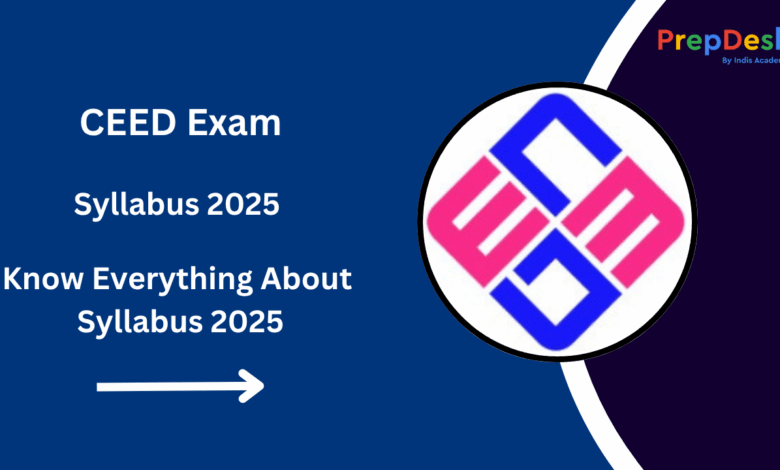CEED Exam Syllabus 2025 – Complete Topic-Wise Guide & Pattern
Get the complete CEED Exam Syllabus 2025 with detailed Part-A and Part-B topics, exam pattern, marking scheme, and preparation tips. Covers visualization, creativity, reasoning, and design knowledge to help you excel in the M.Des entrance.

The Common Entrance Examination for Design (CEED) is a prestigious national-level examination conducted by IIT Bombay for admission into Master of Design (M.Des) and Ph.D. programs across top institutions such as IIT Bombay, IISc Bangalore, IIT Delhi, IIT Guwahati, IIT Hyderabad, IIT Kanpur, IIT Roorkee, and IIITDM Jabalpur. It evaluates candidates’ abilities in creativity, design thinking, analytical reasoning, visual communication, and problem-solving. CEED is known for its focus on assessing both creative aptitude and technical understanding, making it an essential gateway for aspiring designers.
2. Exam Overview
| Component | Description |
|---|---|
| Parts | Part-A (online objective) and Part-B (offline descriptive) |
| Part-A | 1 hour; 100 marks; Objective type (NAT, MSQ, MCQ) |
| Part-B | 2 hours; 100 marks; Descriptive drawing and design problem-solving |
| Final Score | 25% Part-A + 75% Part-B |
| Shortlisting | Part-B evaluated only if Part-A cutoff is cleared |
| Eligibility | Open to graduates from any discipline meeting the eligibility criteria |
3. Detailed Syllabus – Subject-wise Topics & Guide
Part-A Syllabus
Part-A assesses your analytical and creative aptitude through objective-type questions.
| Subject | Description |
| Visualization and Spatial Reasoning | Assessing the ability to mentally transform and manipulate 2D and 3D shapes, understand perspectives, and visualize transformations. |
| Practical and Scientific Knowledge | Evaluating understanding of basic scientific and engineering concepts related to design, including mechanics, materials, and structural behavior. |
| Observation and Design Sensitivity | Measuring attentiveness to visual details such as patterns, textures, symmetry, and proportions, as well as aesthetic appreciation. |
| Environment and Society Awareness | Testing awareness of cultural, social, and environmental factors affecting design, including sustainability and community impact. |
| Analytical and Logical Reasoning | Problem-solving using logical sequences, data analysis, pattern recognition, and structured thinking. |
| Language and Comprehension | Reading comprehension skills, vocabulary usage, grammatical correctness, and interpretation of written material. |
| Creativity and Innovation | Ability to think outside the box, conceptualize unique ideas, and use analogies and metaphors effectively. |
| Art and Design Knowledge | Awareness of art history, major design movements, influential designers, and current industry trends. |
| Design Methods and Practices | Understanding design processes, material selection, manufacturing methods, ergonomics, and usability. |
Part-B Syllabus
Part-B focuses on creative application and practical design problem-solving.
| Subject | Description |
| Drawing | Demonstrating skills in freehand sketching, human figures, perspective drawing, shading, and proportion. |
| Creativity | Generating innovative and original solutions to design problems, presenting unique concepts. |
| Communication | Effectively conveying ideas through visual representation and explanatory text. |
| Problem Identification | Recognizing and defining real-world design problems based on user needs and context. |
| Form and Visual Sensitivity | Showcasing understanding of design aesthetics, form balance, and proportional relationships. |
4. Marks Distribution
| Part-A (Online) | Marks |
| NAT, MSQ, MCQ across 9 topic areas | 100 marks total (distribution may vary by year) |
| Part-B (Offline) | Marks |
| Drawing, Creativity, Communication, Problem Identification, Form Sensitivity | 5 questions × 20 marks = 100 marks |
5. Syllabus PDF Download
You can access the complete and official CEED 2025 syllabus and pattern in the CEED 2025 Official Brochure (PDF).
6. Recommended Books & Study Material
| Resource | Author/Publisher | Purpose |
| UCEED & NID Exam Mock Test | iMADE Creative Studio | Practice objective and creative sections |
| Think Design • Execute Design | Various | Enhance sketching skills and creative ideation |
| CLEVER Pappras | Various | Topic-wise guides with solved papers |
| CEED Past Year Papers | IIT Bombay | Understand question style and manage exam timing |
| Design of Everyday Things | Don Norman | Learn design thinking principles |
| Drawing on the Right Side of the Brain | Betty Edwards | Improve observational drawing skills |
7. Preparation Strategy
- Understand the Exam Pattern: Familiarize yourself with both Part-A and Part-B formats.
- Master Part-A Topics: Use mock tests and quizzes to improve accuracy and speed.
- Daily Drawing Practice: Dedicate at least 30 minutes daily to freehand sketching and perspective exercises.
- Creative Brainstorming: Regularly practice idea generation to tackle creativity-based questions.
- Analyze Past Papers: Review solutions and understand marking criteria.
- Time Management: Simulate exam conditions to complete tasks within set limits.
- Stay Updated: Follow design-related news, exhibitions, and global design trends.
8. Specialization Guidance
| Specialization | Key Focus |
| Product Design | Focus on ergonomics, product sketches, usability, and materials. |
| Visual Communication | Strengthen branding, typography, and visual storytelling skills. |
| Interaction Design | Practice prototyping, UI/UX principles, and human-computer interaction. |
| Animation & Film Design | Learn storyboarding, character design, and motion graphics. |
| Mobility Design | Understand vehicle design, form development, and transportation ergonomics. |
9. Conclusion
The CEED exam is a comprehensive assessment that requires both analytical and creative mastery. By combining structured study, consistent practice, and an awareness of design trends, candidates can significantly enhance their chances of securing top ranks and admissions to elite institutions.
10. FAQs
Part-A and Part-B marks?
100 marks each.
Negative marking?
Yes, varies by question type in Part-A.
How to prepare for creativity questions?
Engage in conceptual thinking exercises and visual representation practice.
Is the syllabus fixed?
Core topics are consistent, though the exact question style may vary.
Are past papers important?
Yes, they provide insight into question style, marking, and time allocation.
Can non-design graduates apply?
Yes, graduates from any discipline are eligible if they meet the criteria.
How is the final score calculated?
25% weight from Part-A and 75% weight from Part-B.





